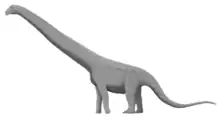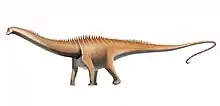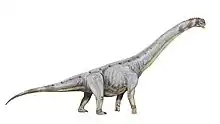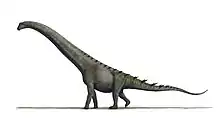Aeolosaurus
Aeolosaurus (/ˌiːoʊloʊˈsɔːrəs/; "Aeolus' lizard") is a genus of titanosaurian sauropod dinosaur from the Late Cretaceous Period of what is now South America. Like most sauropods, it would have been a quadrupedal herbivore with a long neck and tail. Aeolosaurus is well known for a titanosaur, as it is represented by the remains of several individuals belonging to at least three species. However, like most titanosaurs, no remains of the skull are known. The holotype of Aeolosaurus rionegrinus consists of a series of seven tail vertebrae, as well as parts of both forelimbs and the right hindlimb. It was discovered in the Angostura Colorada Formation in Argentina, which dates from the Campanian stage of the Late Cretaceous, about 83 to 74 million years ago.
| Aeolosaurus | |
|---|---|
.jpg.webp) | |
| Left femur of A. maximus | |
| Scientific classification | |
| Kingdom: | Animalia |
| Phylum: | Chordata |
| Clade: | Dinosauria |
| Clade: | Saurischia |
| Suborder: | †Sauropodomorpha |
| Clade: | †Sauropoda |
| Clade: | †Eusauropoda |
| Clade: | †Neosauropoda |
| Clade: | †Macronaria |
| Clade: | †Titanosauria |
| Clade: | †Lithostrotia |
| Clade: | †Aeolosaurini |
| Genus: | †Aeolosaurus Powell, 1987 |
| Species | |
Etymology
This dinosaur is named after the Greek mythological figure Aeolus, Keeper of the Winds in Homer's Odyssey, because of the frequent winds that blow across Patagonia, where the remains were found. The generic name also includes the Greek sauros ('lizard'), the traditional suffix used in dinosaur names. The specific name (A. rionegrinus), refers to its location, in the Rio Negro Province of Argentina. Both genus and species were named and described by Argentine paleontologist Jaime Powell in 1987.[1]
Provenance
Aeolosaurus is a widespread genus of titanosaur known from the Late Cretaceous of South America. Fossils have been collected from the Allen, Angostura Colorada, Bajo Barreal, and Los Alamitos Formations of Argentina and the Adamantina Formation and Marília Formation of Brazil.[2] All Aeolosaurus fossils are from the Campanian and Maastrichtian ages of the Cretaceous period.
History
The type species of Aeolosaurus, Aeolosaurus rionegrinus, was originally named along with the genus in the doctoral thesis of Jaime E. Powell. However, according to the ICZN, names from dissertations are not valid, so it was not formally named until it was published the following year.[1][3] Powell's thesis was ultimately published in 2003, which is sometimes incorrectly cited as having named the genus.[3][4] In 2004, Aeolosaurus and Gondwanatitan were recognized as forming a new group of titanosaurs, which was named Aeolosauridae.[5] In 2007, a second species, A. colhuehuapensis was named, also from Patagonia.[6] A third species, A. maximus, was named in 2011.[2]
Description

Like all sauropods, Aeolosaurus was a large, long-necked, quadrupedal herbivore. A. rionegrinus was roughly 14 meters (46 ft) long and 6 tonnes (6.6 short tons) in weight according to Gregory S. Paul.[7] In 2020 Molina-Pérez and Larramendi gave a larger estimation of 18.1 meters (60 ft) and 14.7 tonnes (16.2 short tons).[8] A. rionegrinus was heavily-built for a titanosaur, with limb bones similar in robustness to those of Saltasaurus, whereas A. maximus appears to have been more slender.[2]
Aeolosaurs, Aeolosaurus in particular, have very distinctive caudal vertebrae. The genus Aeolosaurus is diagnosed by the shared presence of down-curved prezygapophyses on its anterior caudal vertebrae and chevrons from the anterior and middle portions of the tail with concave posterodorsal surfaces that contain double articular facets.[2] The caudal vertebrae of Aeolosaurus and the related genus Gondwanatitan share anteriorly-inclined neural spines in the anterior caudal vertebrae.[9] The vertebrae from the middle part of its tail had elongated centra.[10] Aeolosaurus had vertebral lateral fossae that resembled shallow depressions.[10] Fossae that similarly resemble shallow depressions are known from Saltasaurus, Alamosaurus, Malawisaurus, and Gondwanatitan.[10] Its middle tail vertebrae's neural spines angled anteriorly when the vertebrae are aligned.[10] These vertebrae resemble those of Cedarosaurus, Venenosaurus, and Gondwanatitan.[10] The tail of Aeolosaurus was apparently curved strongly downward, a trait likely shared with other members of Aeolosaurini.[11] This curvature would likely have led to the posterior portion of the tail being very low to the ground, though likely not touching it. The curved base of the tail may have enabled the m. caudofemoralis longus, which extended from the femur to the tail vertebrae, to exert more force while retracting the hindlimb.[11]
Aeolosaurus, like many lithostrotian titanosaurs, bore osteoderms.[12] However, its osteoderms were unusual and most closely resemble those of Mendozasaurus.[13] As in all osteoderm-bearing titanosaurs, the osteoderms were probably arranged in one or two rows along the flanks.
Classification
Aeolosaurus is most closely related to the genera Gondwanatitan and Panamericansaurus.[14][15] Together with Gondwanatitan, it defines the clade Aeolosaurini.[5] The two Aeolosaurus species from Argentina, A. rionegrinus and A. colhuehuapensis, appear to be more closely related to each other than to the Brazilian species A. maximus.[2]

The classification of Aeolosaurus and its relatives is heavily based on features of the tail vertebrae, which are the only bones preserved in most aeolosaurs.[2]
Aeolosaurus has been included in several cladistic analyses. The phylogeny of Aeolosaurini here is based on Gallina and Otero 2015, with the application of clade names according to their phylogenetic definitions.[2][5][15][16][17]
| Aeolosaurini |
| ||||||||||||||||||||||||||||||||||||||||||||||||||||||||||||
Species
There are currently three named valid species of Aeolosaurus, as well as several specimens that have been referred to the genus but not given a species. In addition, Gondwanatitan faustoi, the closest known relative of the genus, has been proposed to represent an additional species of Aeolosaurus, as Aeolosaurus faustoi.[18] However, Gondwanatitan is typically considered a distinct genus.[3]
- Aeolosaurus rionegrinus is the type species of Aeolosaurus.[1] It is known from a single specimen, MJG-R 1, that consists of seven caudal vertebrae and many appendicular elements.[4] Its limb bones suggest that it was heavily-built, similar to Saltasaurus. It is found in the Angostura Colorada Formation of Argentina.
- Aeolosaurus colhuehuapensis is known only from 21 caudal vertebrae.[6] It is found in the Lago Colhue Huapi Formation of Argentina.[19]
- Aeolosaurus maximus is the largest species of Aeolosaurus, and is known from an incomplete skeleton including cervical, dorsal, and caudal vertebrae, ribs, and appendicular elements.[2] It was relatively gracile for a titanosaur. It is found in the Adamantina Formation of Brazil.

Another specimen, described in 1993, consists of five tail vertebrae, and some bones from the forelimb and pelvis. Since there are two right ulna (forearm) bones, the specimen must consist of at least two individuals. These bones were also associated with two osteoderms, or bony armor plates, providing evidence that this dinosaur was armored. This specimen is from the Allen Formation of Rio Negro, dating back about 70 to 68 million years ago to the middle Maastrichtian stage. While this specimen bears features that characterize the genus Aeolosaurus, it is from a younger time period and shows enough differences that the authors recognized it as a possible second species.[12] Additional material from the same quarry, described in 2013, shows that the quarry contained the remains at least three individuals of Aeolosaurus.[20]
Another partial skeleton, including four more tail vertebrae and material from both limbs on the left side of the body, was described in 1997. This was recovered from the Los Alamitos Formation of Rio Negro, which falls between the other two dates. This specimen was also referred to the genus Aeolosaurus, but not to the species A. rionegrinus, and may represent a third species.[21]
However, since the genus Aeolosaurus is not well known, the authors chose not to formally name either of these possible new species. For now, they are both simply known as "Aeolosaurus sp." Future discoveries may give scientists more information on variation within the genus, and show that all of the above specimens belong to A. rionegrinus, or that they merit being formally named.
A middle caudal vertebra from the Marília Formation, CPP 248, cannot be evaluated for any diagnostic features of the genus Aeolosaurus.[3] However, because it clearly does not belong to Gondwanatitan, it is most likely that this vertebra represents Aeolosaurus, a genus otherwise unknown from the Marília Formation.[2]
Another series of 15 tail vertebrae was assigned to Aeolosaurus in the original description, but it was later determined that the series does not belong to this genus, as it lacks several features found in the other specimens of Aeolosaurus.[1][12]
Paleoecology
Aeolosaurus lived during the Campanian and Maastrichtian ages of the Late Cretaceous and shared its environment with hadrosaurs.[2][4] The unnamed Allen Formation species of Aeolosaurus inhabited an environment that it shared with five other species of titanosaur, including Rocasaurus muniozi, as well as hadrosaurs and ankylosaurs.[20]

References
- Powell, Jaime Eduardo (1987). "The Late Cretaceous fauna of Los Alamitos, Patagonia, Argentina. Part VI. The titanosaurids". Revista del Museo Argentino de Siencias Naturales. 3: 111–142.
- Santucci, Rodrigo M.; de Arruda-Campos, Antonio C. (2011). "A new sauropod (Macronaria, Titanosauria) from the Adamantina Formation, Bauru Group, Upper Cretaceous of Brazil and the phylogenetic relationships of Aeolosaurini". Zootaxa. 3085: 1–33. doi:10.11646/zootaxa.3085.1.1.
- Martinelli, A. G.; Riff, D.; Lopes, R. P. (2011). "Discussion about the occurrence of the genus Aeolosaurus Powell 1987 (Dinosauria, Titanosauria) in the Upper Cretaceous of Brazil". Gaea. 7 (1): 34–40. Bibcode:2011Gaea....7...34M. doi:10.4013/gaea.2011.71.03.
- Powell, Jaime Eduardo (2003). "Revision of South American titanosaurid dinosaurs: palaeobiological, palaeobiogeographical, and phylogenetic aspects". Records of the Queen Victoria Museum. 111.
- Franco-Rosas, Aldirene Costa; Salgado, Leonardo; Rosas, Claudio Fabían; Carvalho, Ismar de Souza (2004). "Nuevos materiales de titanosaurios (Sauropoda) en el Cretácico Superior de Mato Grosso, Brasil". Revista Brasileira de Paleontologia. 7 (3): 329–336. doi:10.4072/rbp.2004.3.04.
- Casal, G.; Martínez, R. D.; Luna, M.; Sciutto, J. C.; Lamanna, M. (2007). "Aeolosaurus colhuehuapensis sp. nov. (Sauropoda, Titanosauria) de la Formación Bajo Barreal, Cretácico Superior de Argentina" [Aeolosaurus colhuehuapensis sp. nov. (Sauropoda, Titanosauria) from the Bajo Barreal Formation, Upper Cretaceous of Argentina]. Revista Brasileira de Paleontologia (in Portuguese). 10 (1): 53–62. doi:10.4072/rbp.2007.1.05.
- Paul, G. S. (2010). The Princeton Field Guide to Dinosaurs. Princeton University Press.
- Molina-Pérez & Larramendi (2020). Dinosaur Facts and Figures: The Sauropods and Other Sauropodomorphs. New Jersey: Princeton University Press. p. 266.
- Kellner, Alexander W. A.; de Azevedo, Sergio A. K. (1999). "A new sauropod dinosaur (Titanosauria) from the Late Cretaceous of Brazil". National Science Museum Monographs. 15: 111–142.
- Tidwell, Virginia; Carpenter, Kenneth; Meyer, S. (2001). "New titanosauriform (Sauropoda) from the Poison Strip Member of the Cedar Mountain Formation (Lower Cretaceous), Utah". In Tanke, D. H.; Carpenter, Kenneth (eds.). Mesozoic Vertebrate Life. Indiana University Press. pp. 139–165.
- Vidal, Luciano da Silva; Pereira, Paulo Victor Luiz Gomes da Costa; Tavares, Sandra; Brusatte, Stephen L.; Bergqvist, Lílian Paglarelli; Candeiro, Carlos Roberto dos Anjos (2020). "Investigating the enigmatic Aeolosaurini clade: the caudal biomechanics of Aeolosaurus maximus (Aeolosaurini/Sauropoda) using the neutral pose method and the first case of protonic tail condition in Sauropoda". Historical Biology: 1–21. doi:10.1080/08912963.2020.1745791.
- Salgado, Leonardo; Coria, Rodolfo A. (1993). "El genero Aeolosaurus (Sauropoda, Titanosauridae) en la Formacion Allen (Campaniano-Maastrichtiano) de la provincia de Rio Negro, Argentina". Ameghiniana. 30 (2): 119–128.
- Vidal, Daniel; Ortega, Francisco; Sanz, José Luis (2014). "Titanosaur osteoderms from the Upper Cretaceous of Lo Hueco (Spain) and their implications on the armor of Laurasian titanosaurs". PLoS ONE. 9 (8): e102488. Bibcode:2014PLoSO...9j2488V. doi:10.1371/journal.pone.0102488. PMC 4131861. PMID 25118985.
- Coria, Rodolfo A.; Filippi, Leonardo S.; Chiappe, Luis M.; García, Rodolfo; Arcucci, Andrea B. (2013). "Overosaurus paradasorum gen. et sp. nov., a new sauropod dinosaur (Titanosauria: Lithostrotia) from the Late Cretaceous of Neuquén, Patagonia, Argentina". Zootaxa. 3683 (4): 357–376. doi:10.11646/zootaxa.3683.4.2. PMID 25250458.
- Gallina, Pablo Ariel; Otero, Alejandro (2015). "Reassessment of Laplatasaurus araukanicus (Sauropoda: Titanosauria) from the Upper Cretaceous of Patagonia, Argentina". Ameghiniana. 52 (5): 487–501. doi:10.5710/amgh.08.06.2015.2911.
- Calvo, J. O.; González-Riga, B. J.; Porfiri, J. D. (2007). "A new titanosaur sauropod from the Late Cretaceous of Neuquén, Patagonia, Argentina". Arquivos do Museu Nacional, Rio de Janeiro. 65 (4): 485–504.
- Calvo, J. O.; Porfiri, J. D.; González-Riga, B. J.; Kellner, A. W. A. (2007). "A new Cretaceous terrestrial ecosystem from Gondwana with the description of a new sauropod dinosaur". Anais da Academia Brasileira de Ciências. 79 (3): 529–541. doi:10.1590/s0001-37652007000300013. PMID 17768539.
- Santucci, Rodrigo Miloni; Bertini, Reinaldo José (2001). "Distribução paleogeográfica e biocronológica dos titanossauros (Saurischia, Sauropoda) do Grupo Bauru, Cretáceo Superior do sudeste Brasileiro". Revista Brasileira de Geociências. 31 (3): 307–314. doi:10.25249/0375-7536.2001313307314.
- Casal GA, Allard JO and Foix N (2015) Análisis estratigráfico y paleontológico del Cretácico Superior en la Cuenca del Golfo San Jorge: nueva unidad litoestratigráfica para el Grupo Chubut. Revista de la Asociación Geológica Argentina 72: 77–95.
- Garcia, R. A.; Salgado, L. (2013). "The titanosaur sauropods from the late Campanian-early Maastrichtian Allen Formation of Salitral Moreno, Río Negro, Argentina". Acta Palaeontologica Polonica. 58 (2): 269–284. doi:10.4202/app.2011.0055.
- Salgado, L.; Coria, R. A.; Calvo, J. O. (1997). "Presence of the genus Aeolosaurus (Sauropoda, Titanosauridae) in the Los Alamitos Formation (Late Cretaceous) of the Rio Negro Province". Revista Guarulhos - Geociencias. 2 (2): 44–49.












